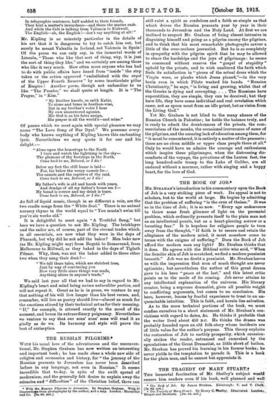THE TRAGEDY OF MARY STUART.t THE immortal fascination of Mr.
Shelley's subject wouM ensure him readers even if his book, well planned and well
• The Book of Job. By James Strains. Edinburgh: T, and T. Clara.. 6€1. net.] t The Tragedy of Mary Stuart. By Henry C. Shelley. Illustrated. Iamdfms, Harper and Brothers. Des. ad. net.]
'written, did not on its 'own account deserve them. Well planned, that is to say, from Mr. Shelley's special point of view, at which his readers may not all be quite prepared to place themselves. By doing so, and by ignoring much that Mr. Shelley does not care to dwell upon, they will become possessed of a very direct history of that short but fateful period in Queen Mary's life, which began with the murder of Darnley and ended with the Queen's escape to England in May 1568. Her life up to the autumn of 1566, and the English captivity, cut short by Elizabeth in 1586, are dealt with in a few pages of "prologue" and "epilogue."
There is a certain theatrical fitness, no doubt, in this arrange- ment. It was those few months of trouble and madness, led up to by Mary Stuart's birth, character, training, and position, which made the centre point of her life, gave her a unique place in history, and in fate's stern sequence threw her into the hands of a deadlier enemy than the roughest of her Scots lords. But the fact remains that one cannot fairly under- stand the " tragedy" or penetrate that fog of mystery which hangs round it still without a very careful study of all that went before; and this is why, as Mr. Shelley complains, biographies of the Queen of Scots are generally long. Also, though the actual " tragedy" began with Darnley's murder— or rather, with Mary's arrival in Scotland—it certainly did not end with the day on which she crossed the Solway and landed at Workington. Real students of the subject, there- fore, will find the arrangement of this book more effective than helpful.
Mr. Shelley says in his preface that he is not a partisan but a chronicler ; that his book is " not an argument for or against the Queen of Scots." He claims a more complete impartiality than has been shown by former writers on the subject. He is no doubt quite sincere in this claim, and it may not be his fault that the book reads as severe and unmitigated condemnation. Possibly not undeserved: we do not tnter on that argument. Our point is that, without any notes or references, the book is evidently inspired by the witness of Mary Stuart's enemies, and by that alone. It leaves the impression that, beyond a few admirers in her own day, history knows nothing of her defenders or apologists ; it quotes the Casket Letters without a hint that their authenticity has ever been doubted; it accepts without question, apparently, every scurrilous accusa- tion, every breath of evil rumour with which revenge or hypocrisy blackened the name of an unlucky young princess thrown friendless, in circumstances made even more difficult by her own temperament, on most inhospitable shores. "After all," Mr. Shelley allows, "her position was one of great loneliness and danger; her enemies were beyond number, her friends exceedingly few." If ever there were excuses for a drame passionnel, they undoubtedly existed in the case of Mary Stuart, and Mr. Shelley's book would have been more valuable, certainly more really impartial, had he thought fit to show something of the other side of the shield.















































 Previous page
Previous page